wheel PONTIAC GRAND PRIX 2008 User Guide
[x] Cancel search | Manufacturer: PONTIAC, Model Year: 2008, Model line: GRAND PRIX, Model: PONTIAC GRAND PRIX 2008Pages: 450, PDF Size: 2.64 MB
Page 104 of 450
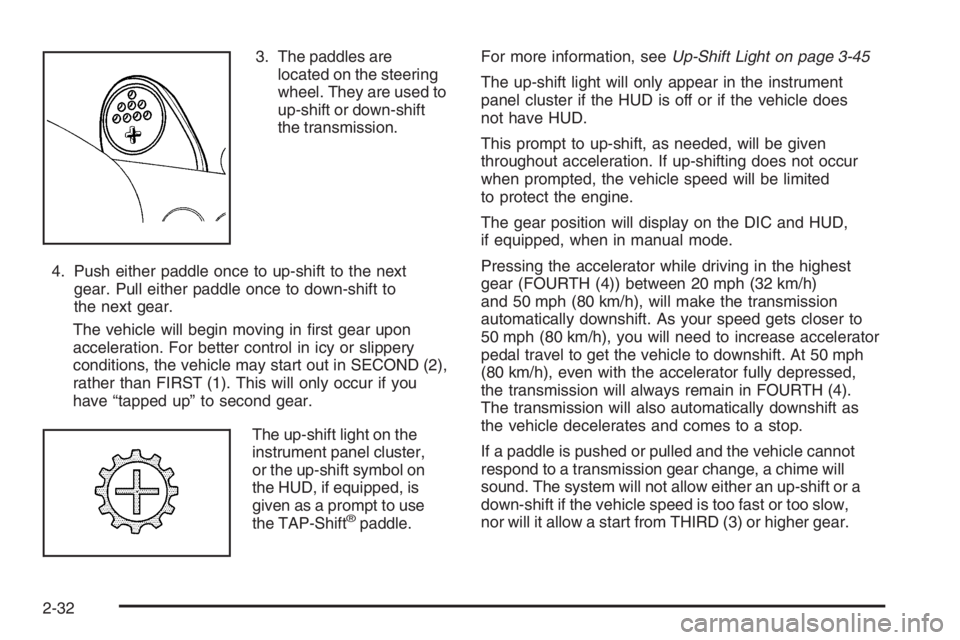
3. The paddles are
located on the steering
wheel. They are used to
up-shift or down-shift
the transmission.
4. Push either paddle once to up-shift to the next
gear. Pull either paddle once to down-shift to
the next gear.
The vehicle will begin moving in �rst gear upon
acceleration. For better control in icy or slippery
conditions, the vehicle may start out in SECOND (2),
rather than FIRST (1). This will only occur if you
have “tapped up” to second gear.
The up-shift light on the
instrument panel cluster,
or the up-shift symbol on
the HUD, if equipped, is
given as a prompt to use
the TAP-Shift
®paddle.For more information, seeUp-Shift Light on page 3-45
The up-shift light will only appear in the instrument
panel cluster if the HUD is off or if the vehicle does
not have HUD.
This prompt to up-shift, as needed, will be given
throughout acceleration. If up-shifting does not occur
when prompted, the vehicle speed will be limited
to protect the engine.
The gear position will display on the DIC and HUD,
if equipped, when in manual mode.
Pressing the accelerator while driving in the highest
gear (FOURTH (4)) between 20 mph (32 km/h)
and 50 mph (80 km/h), will make the transmission
automatically downshift. As your speed gets closer to
50 mph (80 km/h), you will need to increase accelerator
pedal travel to get the vehicle to downshift. At 50 mph
(80 km/h), even with the accelerator fully depressed,
the transmission will always remain in FOURTH (4).
The transmission will also automatically downshift as
the vehicle decelerates and comes to a stop.
If a paddle is pushed or pulled and the vehicle cannot
respond to a transmission gear change, a chime will
sound. The system will not allow either an up-shift or a
down-shift if the vehicle speed is too fast or too slow,
nor will it allow a start from THIRD (3) or higher gear.
2-32
Page 114 of 450
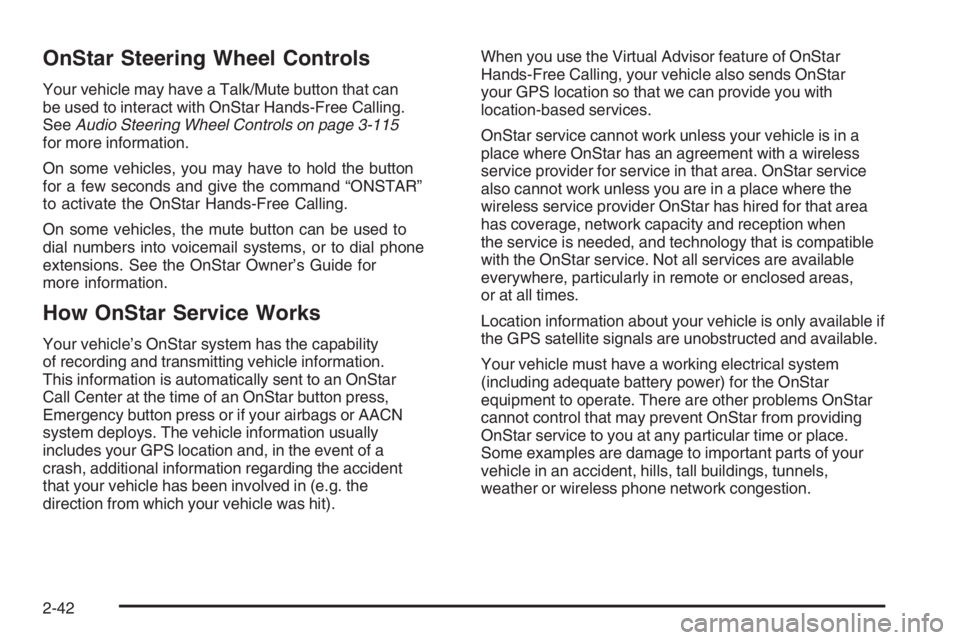
OnStar Steering Wheel Controls
Your vehicle may have a Talk/Mute button that can
be used to interact with OnStar Hands-Free Calling.
SeeAudio Steering Wheel Controls on page 3-115
for more information.
On some vehicles, you may have to hold the button
for a few seconds and give the command “ONSTAR”
to activate the OnStar Hands-Free Calling.
On some vehicles, the mute button can be used to
dial numbers into voicemail systems, or to dial phone
extensions. See the OnStar Owner’s Guide for
more information.
How OnStar Service Works
Your vehicle’s OnStar system has the capability
of recording and transmitting vehicle information.
This information is automatically sent to an OnStar
Call Center at the time of an OnStar button press,
Emergency button press or if your airbags or AACN
system deploys. The vehicle information usually
includes your GPS location and, in the event of a
crash, additional information regarding the accident
that your vehicle has been involved in (e.g. the
direction from which your vehicle was hit).When you use the Virtual Advisor feature of OnStar
Hands-Free Calling, your vehicle also sends OnStar
your GPS location so that we can provide you with
location-based services.
OnStar service cannot work unless your vehicle is in a
place where OnStar has an agreement with a wireless
service provider for service in that area. OnStar service
also cannot work unless you are in a place where the
wireless service provider OnStar has hired for that area
has coverage, network capacity and reception when
the service is needed, and technology that is compatible
with the OnStar service. Not all services are available
everywhere, particularly in remote or enclosed areas,
or at all times.
Location information about your vehicle is only available if
the GPS satellite signals are unobstructed and available.
Your vehicle must have a working electrical system
(including adequate battery power) for the OnStar
equipment to operate. There are other problems OnStar
cannot control that may prevent OnStar from providing
OnStar service to you at any particular time or place.
Some examples are damage to important parts of your
vehicle in an accident, hills, tall buildings, tunnels,
weather or wireless phone network congestion.
2-42
Page 117 of 450
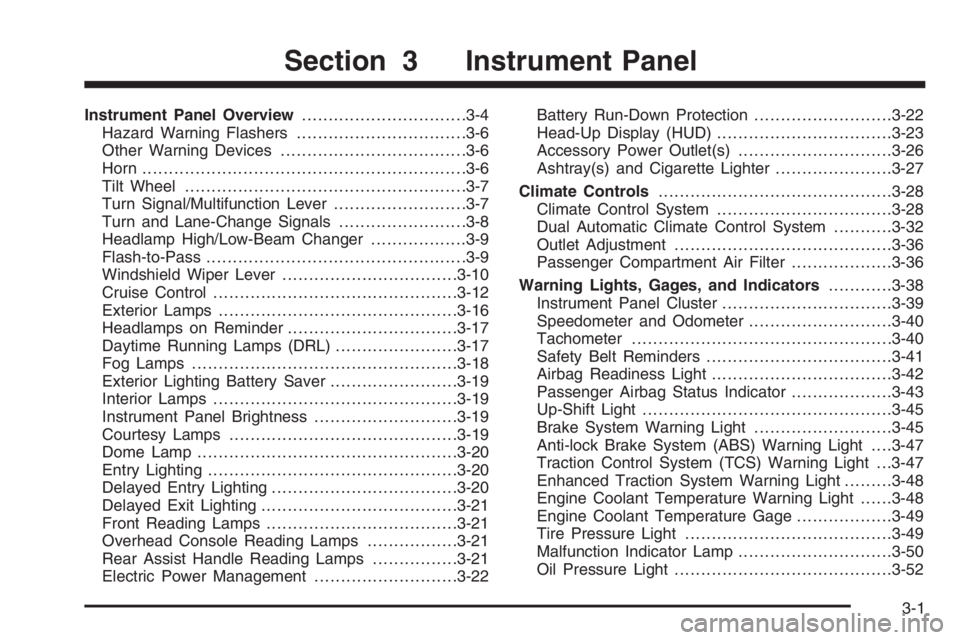
Instrument Panel Overview...............................3-4
Hazard Warning Flashers................................3-6
Other Warning Devices...................................3-6
Horn .............................................................3-6
Tilt Wheel.....................................................3-7
Turn Signal/Multifunction Lever.........................3-7
Turn and Lane-Change Signals........................3-8
Headlamp High/Low-Beam Changer..................3-9
Flash-to-Pass.................................................3-9
Windshield Wiper Lever.................................3-10
Cruise Control..............................................3-12
Exterior Lamps.............................................3-16
Headlamps on Reminder................................3-17
Daytime Running Lamps (DRL).......................3-17
Fog Lamps ..................................................3-18
Exterior Lighting Battery Saver........................3-19
Interior Lamps..............................................3-19
Instrument Panel Brightness...........................3-19
Courtesy Lamps...........................................3-19
Dome Lamp .................................................3-20
Entry Lighting...............................................3-20
Delayed Entry Lighting...................................3-20
Delayed Exit Lighting.....................................3-21
Front Reading Lamps....................................3-21
Overhead Console Reading Lamps.................3-21
Rear Assist Handle Reading Lamps................3-21
Electric Power Management...........................3-22Battery Run-Down Protection..........................3-22
Head-Up Display (HUD).................................3-23
Accessory Power Outlet(s).............................3-26
Ashtray(s) and Cigarette Lighter......................3-27
Climate Controls............................................3-28
Climate Control System.................................3-28
Dual Automatic Climate Control System...........3-32
Outlet Adjustment.........................................3-36
Passenger Compartment Air Filter...................3-36
Warning Lights, Gages, and Indicators............3-38
Instrument Panel Cluster................................3-39
Speedometer and Odometer...........................3-40
Tachometer.................................................3-40
Safety Belt Reminders...................................3-41
Airbag Readiness Light..................................3-42
Passenger Airbag Status Indicator...................3-43
Up-Shift Light...............................................3-45
Brake System Warning Light..........................3-45
Anti-lock Brake System (ABS) Warning Light. . . .3-47
Traction Control System (TCS) Warning Light . . .3-47
Enhanced Traction System Warning Light.........3-48
Engine Coolant Temperature Warning Light......3-48
Engine Coolant Temperature Gage..................3-49
Tire Pressure Light.......................................3-49
Malfunction Indicator Lamp.............................3-50
Oil Pressure Light.........................................3-52
Section 3 Instrument Panel
3-1
Page 118 of 450
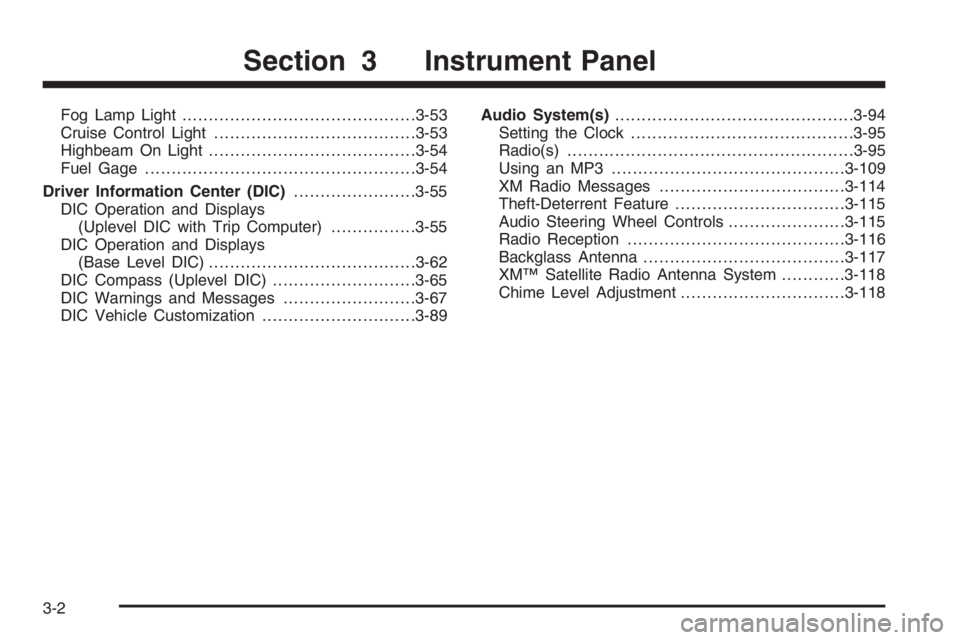
Fog Lamp Light............................................3-53
Cruise Control Light......................................3-53
Highbeam On Light.......................................3-54
Fuel Gage...................................................3-54
Driver Information Center (DIC).......................3-55
DIC Operation and Displays
(Uplevel DIC with Trip Computer)................3-55
DIC Operation and Displays
(Base Level DIC).......................................3-62
DIC Compass (Uplevel DIC)...........................3-65
DIC Warnings and Messages.........................3-67
DIC Vehicle Customization.............................3-89Audio System(s).............................................3-94
Setting the Clock..........................................3-95
Radio(s)......................................................3-95
Using an MP3............................................3-109
XM Radio Messages...................................3-114
Theft-Deterrent Feature................................3-115
Audio Steering Wheel Controls......................3-115
Radio Reception.........................................3-116
Backglass Antenna......................................3-117
XM™ Satellite Radio Antenna System............3-118
Chime Level Adjustment...............................3-118
Section 3 Instrument Panel
3-2
Page 121 of 450
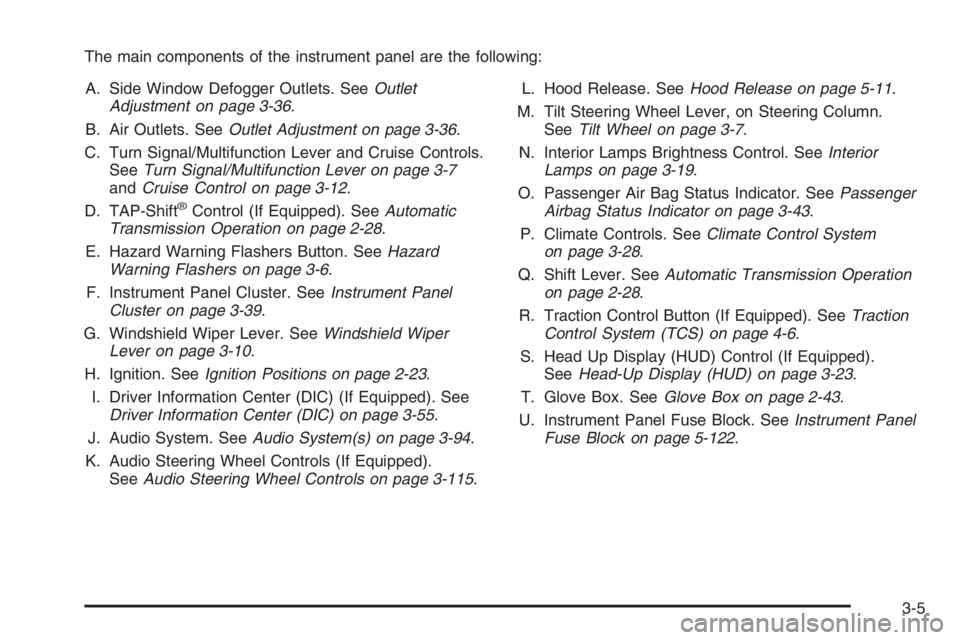
The main components of the instrument panel are the following:
A. Side Window Defogger Outlets. SeeOutlet
Adjustment on page 3-36.
B. Air Outlets. SeeOutlet Adjustment on page 3-36.
C. Turn Signal/Multifunction Lever and Cruise Controls.
SeeTurn Signal/Multifunction Lever on page 3-7
andCruise Control on page 3-12.
D. TAP-Shift
®Control (If Equipped). SeeAutomatic
Transmission Operation on page 2-28.
E. Hazard Warning Flashers Button. SeeHazard
Warning Flashers on page 3-6.
F. Instrument Panel Cluster. SeeInstrument Panel
Cluster on page 3-39.
G. Windshield Wiper Lever. SeeWindshield Wiper
Lever on page 3-10.
H. Ignition. SeeIgnition Positions on page 2-23.
I. Driver Information Center (DIC) (If Equipped). See
Driver Information Center (DIC) on page 3-55.
J. Audio System. SeeAudio System(s) on page 3-94.
K. Audio Steering Wheel Controls (If Equipped).
SeeAudio Steering Wheel Controls on page 3-115.L. Hood Release. SeeHood Release on page 5-11.
M. Tilt Steering Wheel Lever, on Steering Column.
SeeTilt Wheel on page 3-7.
N. Interior Lamps Brightness Control. SeeInterior
Lamps on page 3-19.
O. Passenger Air Bag Status Indicator. SeePassenger
Airbag Status Indicator on page 3-43.
P. Climate Controls. SeeClimate Control System
on page 3-28.
Q. Shift Lever. SeeAutomatic Transmission Operation
on page 2-28.
R. Traction Control Button (If Equipped). SeeTraction
Control System (TCS) on page 4-6.
S. Head Up Display (HUD) Control (If Equipped).
SeeHead-Up Display (HUD) on page 3-23.
T. Glove Box. SeeGlove Box on page 2-43.
U. Instrument Panel Fuse Block. SeeInstrument Panel
Fuse Block on page 5-122.
3-5
Page 122 of 450
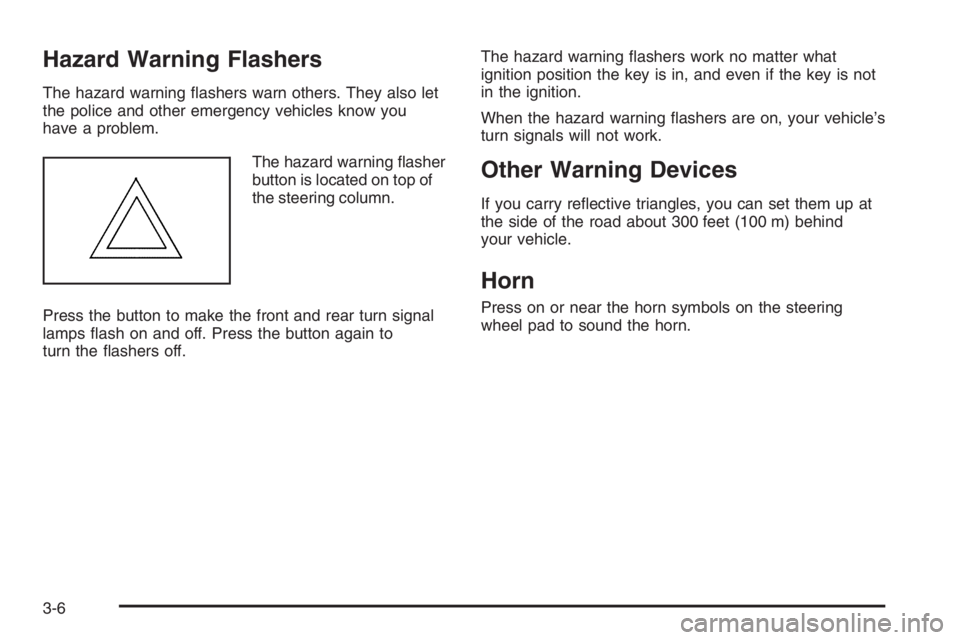
Hazard Warning Flashers
The hazard warning �ashers warn others. They also let
the police and other emergency vehicles know you
have a problem.
The hazard warning �asher
button is located on top of
the steering column.
Press the button to make the front and rear turn signal
lamps �ash on and off. Press the button again to
turn the �ashers off.The hazard warning �ashers work no matter what
ignition position the key is in, and even if the key is not
in the ignition.
When the hazard warning �ashers are on, your vehicle’s
turn signals will not work.
Other Warning Devices
If you carry re�ective triangles, you can set them up at
the side of the road about 300 feet (100 m) behind
your vehicle.
Horn
Press on or near the horn symbols on the steering
wheel pad to sound the horn.
3-6
Page 123 of 450
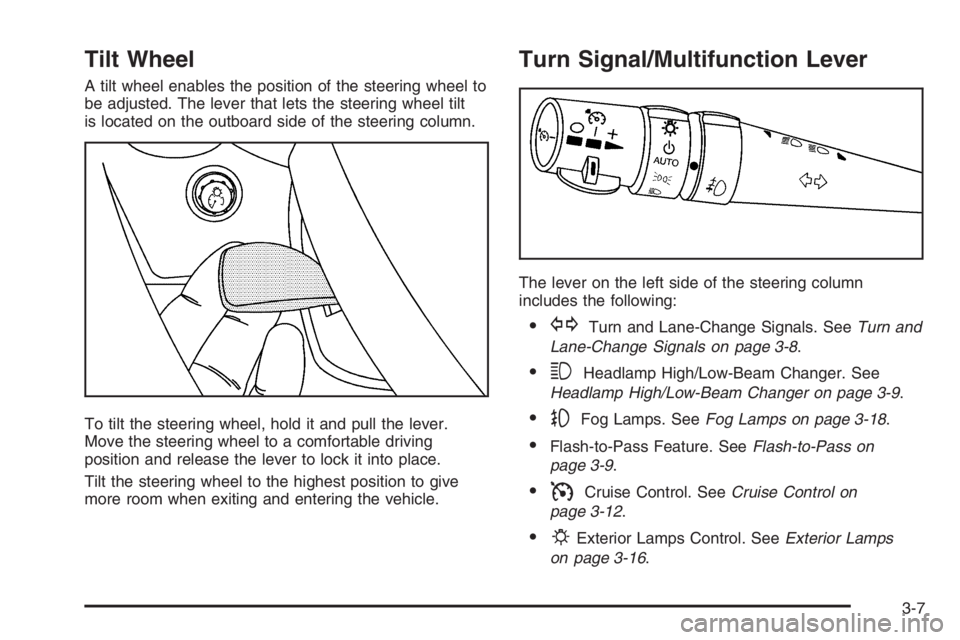
Tilt Wheel
A tilt wheel enables the position of the steering wheel to
be adjusted. The lever that lets the steering wheel tilt
is located on the outboard side of the steering column.
To tilt the steering wheel, hold it and pull the lever.
Move the steering wheel to a comfortable driving
position and release the lever to lock it into place.
Tilt the steering wheel to the highest position to give
more room when exiting and entering the vehicle.
Turn Signal/Multifunction Lever
The lever on the left side of the steering column
includes the following:
GTurn and Lane-Change Signals. SeeTurn and
Lane-Change Signals on page 3-8.
3Headlamp High/Low-Beam Changer. See
Headlamp High/Low-Beam Changer on page 3-9.
-Fog Lamps. SeeFog Lamps on page 3-18.
Flash-to-Pass Feature. SeeFlash-to-Pass on
page 3-9.
ICruise Control. SeeCruise Control on
page 3-12.
PExterior Lamps Control. SeeExterior Lamps
on page 3-16.
3-7
Page 128 of 450
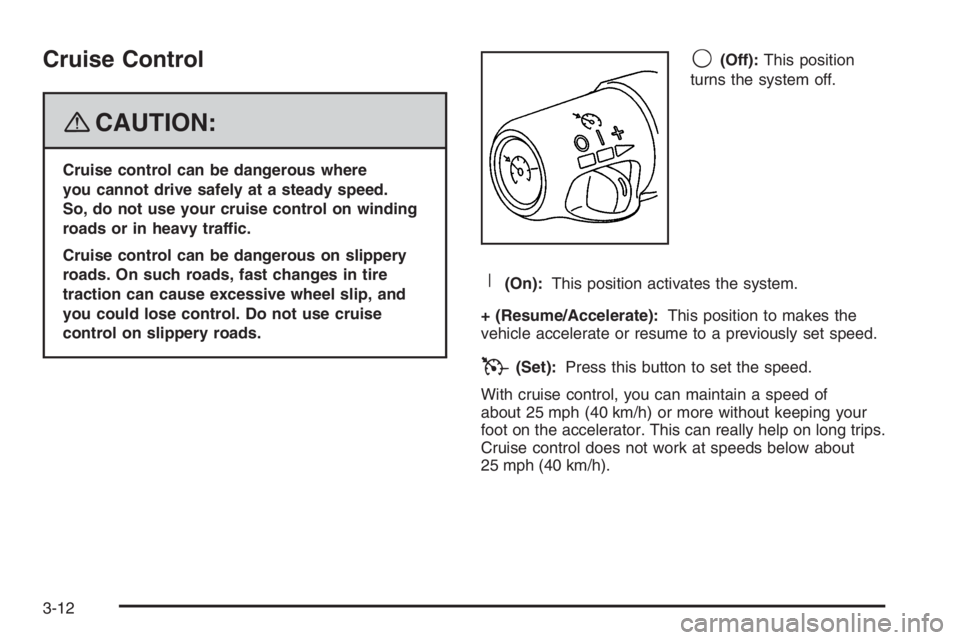
Cruise Control
{CAUTION:
Cruise control can be dangerous where
you cannot drive safely at a steady speed.
So, do not use your cruise control on winding
roads or in heavy traffic.
Cruise control can be dangerous on slippery
roads. On such roads, fast changes in tire
traction can cause excessive wheel slip, and
you could lose control. Do not use cruise
control on slippery roads.
9(Off):This position
turns the system off.
R(On):This position activates the system.
+ (Resume/Accelerate):This position to makes the
vehicle accelerate or resume to a previously set speed.
T(Set):Press this button to set the speed.
With cruise control, you can maintain a speed of
about 25 mph (40 km/h) or more without keeping your
foot on the accelerator. This can really help on long trips.
Cruise control does not work at speeds below about
25 mph (40 km/h).
3-12
Page 129 of 450
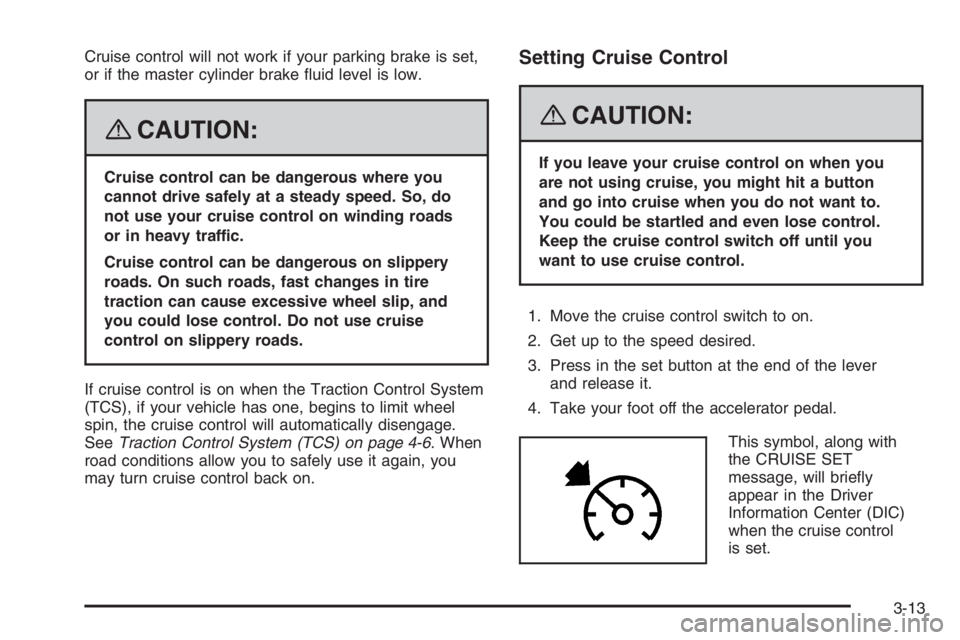
Cruise control will not work if your parking brake is set,
or if the master cylinder brake �uid level is low.
{CAUTION:
Cruise control can be dangerous where you
cannot drive safely at a steady speed. So, do
not use your cruise control on winding roads
or in heavy traffic.
Cruise control can be dangerous on slippery
roads. On such roads, fast changes in tire
traction can cause excessive wheel slip, and
you could lose control. Do not use cruise
control on slippery roads.
If cruise control is on when the Traction Control System
(TCS), if your vehicle has one, begins to limit wheel
spin, the cruise control will automatically disengage.
SeeTraction Control System (TCS) on page 4-6. When
road conditions allow you to safely use it again, you
may turn cruise control back on.
Setting Cruise Control
{CAUTION:
If you leave your cruise control on when you
are not using cruise, you might hit a button
and go into cruise when you do not want to.
You could be startled and even lose control.
Keep the cruise control switch off until you
want to use cruise control.
1. Move the cruise control switch to on.
2. Get up to the speed desired.
3. Press in the set button at the end of the lever
and release it.
4. Take your foot off the accelerator pedal.
This symbol, along with
the CRUISE SET
message, will brie�y
appear in the Driver
Information Center (DIC)
when the cruise control
is set.
3-13
Page 132 of 450
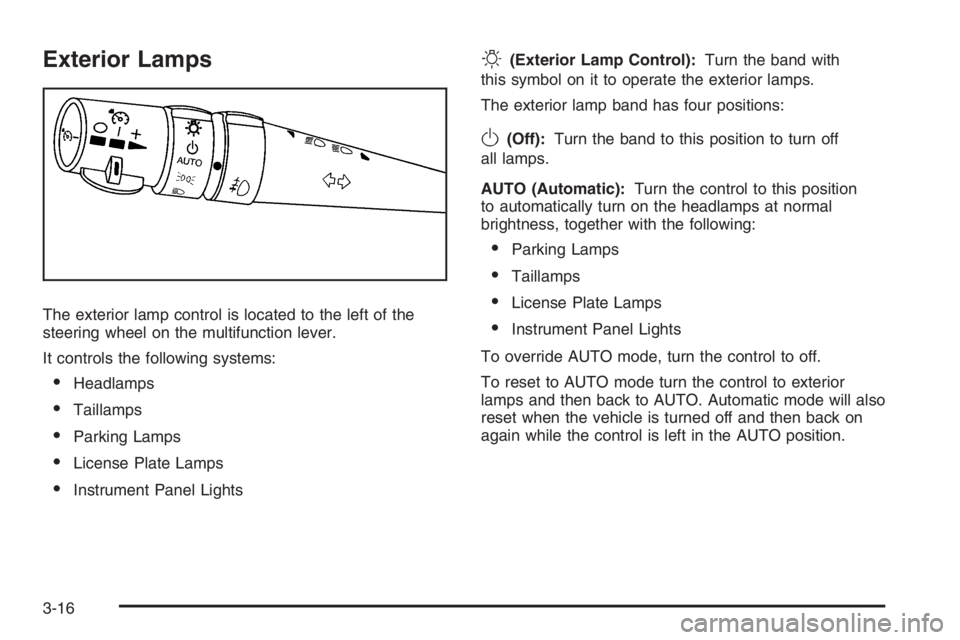
Exterior Lamps
The exterior lamp control is located to the left of the
steering wheel on the multifunction lever.
It controls the following systems:
Headlamps
Taillamps
Parking Lamps
License Plate Lamps
Instrument Panel Lights
O(Exterior Lamp Control):Turn the band with
this symbol on it to operate the exterior lamps.
The exterior lamp band has four positions:
O(Off):Turn the band to this position to turn off
all lamps.
AUTO (Automatic):Turn the control to this position
to automatically turn on the headlamps at normal
brightness, together with the following:
Parking Lamps
Taillamps
License Plate Lamps
Instrument Panel Lights
To override AUTO mode, turn the control to off.
To reset to AUTO mode turn the control to exterior
lamps and then back to AUTO. Automatic mode will also
reset when the vehicle is turned off and then back on
again while the control is left in the AUTO position.
3-16